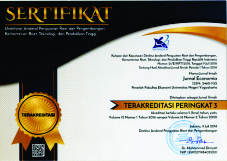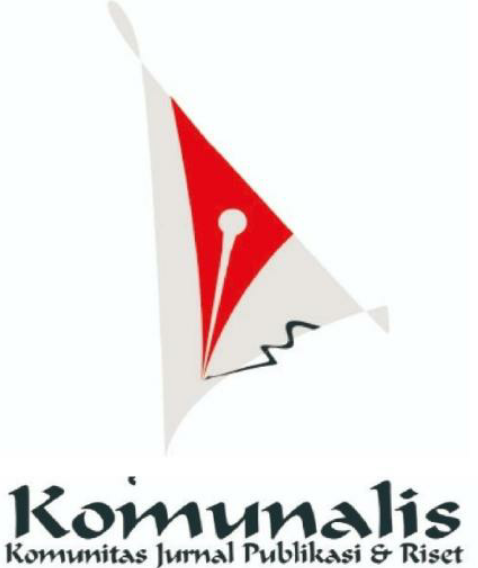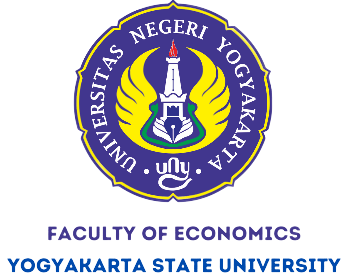Spatial Analysis of Fiscal Balance Fund on Income Inequality in West Kalimantan
Downloads
Abstract: The research aims to analyze the effect of fiscal balance fund on income inequality in West Kalimantan by considering spatial inter-relationships between existing districts/cities. The study showed that the Spatial Durbin Model with fixed effect was empirically suitable. A variant of spatial autoregression model using Gini Ratio during the period of 2010 – 2018 in 14 districts/cities of West Kalimantan. The study concludes that income disparities between districts/cities were low and constant or the income was relatively distributed per capita. Spatial interactions between districts/cities and their neighbors are also relatively low. Spatial aspect, fiscal balance fund and regional minimum wage have a significant negative effect. On the contrary, the industrial workforce, educated workforce and medical personnel do not affect income inequality in West Kalimantan. This study provides academics with the understanding of the importance of spatial dependence in income inequality model because the economic activity is always related to the neighbor.
Keywords: fiscal balance fund, income inequality, spatial aspect
Analisis Spasial Dana Perimbangan Terhadap Disparitas Pendapatan Kalimantan Barat
Abstrak: Penelitian ini bertujuan menganalisis pengaruh dana perimbangan terhadap disparitas pendapatan di Kalimantan Barat dengan mempertimbangkan keterkaitan spasial antar kabupaten/kota yang ada. Studi ini menghasilkan pemilihan model spasial durbin dengan efek tetap secara empiris sudah tepat. Variansi dari model autoregresif spasial menggunakan Indeks Gini kurun waktu 2010–2018 silang tempat dari 14 kabupaten/kota di Kalimantan Barat. Hasil penelitian menyimpulkan disparitas pendapatan antar kabupaten/kota rendah dan konstan atau relatif merata dalam pendapatan per kapita. Interaksi spasial antar kabupaten/kota dengan tetangganya juga relatif rendah. Aspek spasial, dana perimbangan dan UMR secara negatif signifikan mempengaruhi disparitas pendapatan. Sedangkan tenaga kerja industri, tenaga kerja terdidik dan tenaga medis tidak mempengaruhi disparitas pendapatan di Kalimantan Barat. Penelitian ini memberikan wawasan bagi kalangan akademisi tentang pentingnya memasukkan spatial dependence kedalam model ketimpangan pendapatan karena proses kegiatan ekonomi selalu berkaitan dengan wilayah tetangga.
Kata kunci: dana perimbangan, disparitas pendapatan, aspek spatial
Downloads
Akita, T., & Miyata, S. (2017). Spatial Dimensions of Expenditure Inequality in A Decentralizing Indonesia. April 2017(720), 75–75. https://doi.org/10.1007/978-1-349-67278-3_116.
Amelia, A., & Ekobelawati, F. (2019). Efektivitas Transfer Pusat Terhadap Perekonomian Kalimantan Barat. Buletin Studi Ekonomi, 23(1), 124–137. https://ojs.unud.ac.id/index.php/bse/article/view/47066.
Anselin, L., & Rey, S. J. (2014). Modern Spatial Econometrics in Practice: A Guide to GeoDa, GeoDaSpace and PySAL. In Modern Spatial Econometrics in Practice: A Guide to GeoDa, GeoDaSpace and PySAL. https://sergerey.org/giasp16/pdfs/anselin_rey_weights.pdf.
Arbia, G. (2014). A Primer for Spatial Econometrics: With Applications in R. In PalgraveTexts in Econometrics (1st Editio). Palgrave Macmillan. https://doi.org/10.1057/9781137317940.
Aritenang, A. F. (2014). The Spatial Effect of Fiscal Decentralisation on Regional Disparities: The Case from Indonesia. Indonesian Journal of Geography, 46(1), 1. https://doi.org/10.22146/ijg.4985.
Belotti, F., Hughes, G., & Piano Mortari, A. (2017). Spatial Panel Data Models Using Stata. SSRN Electronic Journal, 17(1). https://doi.org/10.2139/ssrn.2754703.
Brasili, C., Bruno, F., & Saguatti, A. (2013). A Spatial Econometric Approach to EU Regional Disparities Between Economic and Geographical Periphery. Statistica, 72(3), 299–316. https://doi.org/10.6092/issn.1973-2201/3649.
Dewi, V. N. (2016). Model Estimation For Spatial SUR Panel Data (Case Study Sectoral Employment Model in Indonesia) [Intitut Teknologi Sepuluh Nopember]. https://repository.its.ac.id/41723/1/1314201719-Master-Thesis.pdf.
Elhorst, J. P. (2010). Spatial Panel Data Models. In Handbook of Applied Spatial Analysis: Software Tools, Methods and Applications (pp. 377–378). https://doi.org/10.1007/978-3-642-03647-7.
Elhorst, J. P. (2014). Matlab Software for Spatial Panels. International Regional Science Review, 37(3), 389–405. https://doi.org/10.1177/0160017612452429.
Gezycy, F. (2004). New Regional Definition and Spatial Analysis of Regional Inequalities in Turkey. Related to the Regional Policies of EU. 44th Congress of the European Regional Science Association: "Regions and Fiscal Federalism", 25th - 29th August 2004, Porto, Portugal, 25th-29th August 2004. http://hdl.handle.net/10419/116958.
Goerl, C.-A., & Seiferling, M. (2014). Income Inequality, Fiscal Decentralization and Transfer Dependency. IMF Working Papers, 14(64), 1. https://doi.org/10.5089/9781484354711.001.
Hasna, S. (2013). Analisis Spasial Pengaruh Dana Perimbangan Terhadap Ketimpangan Pendapatan di Provinsi Jawa Timur Tahun 2008-2011. Jurnal BPPK, 06(02), 1–18. https://jurnal.bppk.kemenkeu.go.id/jurnalbppk/article/view/77.
Johansson, M. L. (2016). Intergovernmental Transfers and Regional Development Policies in Poland: Praxis and Problems. DPU Working Papers, 219-(4/201(188), 9–34. https://www.researchgate.net/publication/317313338_Intergovernmental_Transfers_and_Regional_Income_Inequalities_An_Empirical_Analysis_of_Uruguay.
Kurniasih, E. P. (2013). Ketimpangan Wilayah di Provinsi Kalimantan Barat Suatu Kajian terhadap Hipotesis Kuznet. Eksos, 9(1), 36–48. http://repository.polnep.ac.id/xmlui/handle/123456789/322.
Laksono, H., Rustiadi, E., & Siregar, H. (2018). Spillover Spasial Negatif Pertumbuhan Ekonomi Antar Kabupaten/Kota Di Provinsi Jawa Timur. Tataloka, 20(3), 266. https://doi.org/10.14710/tataloka.20.3.266-277.
Leonel, M.-G., Rodríguez-Miranda, A., & Castro-Scavone, P. (2016). Intergovernmental Transfers and Regional Income Inequalities: An Empirical Analysis of Uruguay. Hacienda Publica Espanola, 219(4), 9–34. https://doi.org/10.7866/HPE-RPE.16.4.1.
LeSage, J. P. (2014). What Regional Scientists Need To Know About Spatial Econometrics. Review of Regional Studies, 44(1), 13–32. https://doi.org/10.2139/ssrn.2420725.
LeSage, J. P., & Pace, R. K. (2011). Pitfalls in Higher Order Model Extensions of Basic Spatial Regression Methodology. Review of Regional Studies, 41(1), 13–26. http://journal.srsa.org/ojs/index.php/RRS/article/download/39/205.
LeSage, J., & Pace, R. K. (2009). Introduction to Spatial Econometrics. In Introduction to Spatial Econometrics. https://doi.org/10.1111/j.1467-985x.2010.00681_13.x.
Masaki, T. (2018). The Impact of Intergovernmental Transfers on Local Revenue Generation in Sub-Saharan Africa: Evidence from Tanzania. World Development, 106, 173–186. https://doi.org/10.1016/j.worlddev.2018.01.026.
Muñoz, A. F., Radics, G. A., & Bone, C. (2016). Subnational Fiscal Disparities and Intergovernmental Transfers in LAC. Hacienda Publica Espanola, 219(4), 35–66. https://doi.org/10.7866/HPE-RPE.16.4.2.
Nawaz-ul-huda, S., Burke, F., & Azam, M. (2015). Socio-economic Disparities in Balochistan, Pakistan – A Multivariate Analysis. Geografia : Malaysian Journal of Society and Space, 7(4), 38–50. https://core.ac.uk/download/pdf/11492148.pdf.
Nolan, B., Rahbari, E., Matteo, R., Rivera, L. V., & Nabarro, B. (2017). Inequality and Prosperity in the Industrialized World: Addressing a Growing Challenge. Oxford Martin School & Citi, September. https://www.oxfordmartin.ox.ac.uk/downloads/Citi_GPS_Inequality.pdf.
Shilpi, F. (2013). Understanding the Sources of Spatial Disparity and Convergence : Evidence from Bangladesh. World Bank Let's Talk Development, June. https://papers.ssrn.com/sol3/papers.cfm?abstract_id=2287052.
Soundararajan, P. (2013). Regional Income Convergence in India: A Bayesian Spatial Durbin Model Approach. SSRN Electronic Journal, 1–15. https://doi.org/10.2139/ssrn.2228487.
Suratman, E. (2017). Dana Transfer dan Kesenjangan Wilayah. Kompak, September. https://www.kompak.or.id/storage/app/media/Publication/4_catatan_kebijakan/brief-dana-transfer-10101.pdf.
Wardhana, A., Fauzan, A., & Bustaman, A. (2018). Transfer Pemerintah Pusat dan Ketimpangan Pendapatan Kabupaten dan Kota di Jawa Barat (Pertama). BUDHI MULIA, cv. http://digilib.unimed.ac.id/28207/.















